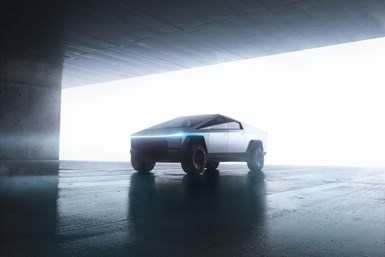Although according to the portion of the Tesla website where you can place an order for the Tesla Cybertruck (all you need is a $100 refundable deposit) indicates that “production nears in late 2021,” the amount of speculation regarding the vehicle since unveiled at the Tesla Design Studio in LA on November 21, 2019, has been so great that it would take multiple years for any other pickup truck to accumulate that degree of interest.
Clever man, that Elon Musk.
Featured Content

The Tesla Cybertruck. If the future is late 2021, this is what the future looks like. (Images: Tesla)
The angular design of the body panels has led some to speculate that the vehicle will be something that can be produced with a pair of shears, a press brake and a weld gun.
Which isn’t entirely incorrect.
Munro Runs the Numbers
Or at least manufacturing and design expert Sandy Munro, who runs Munro & Associates and who is widely known for his teardowns of vehicles including the Tesla Model 3, has determined that the Cybertruck can be manufactured at a mere fraction of the cost that is required by any other truck on the market.
That is, Munro says that the vehicle, which is made out of a stainless steel (Tesla describes it only as “Ultra-Hard 30X Cold-Rolled stainless steel), could be produced in a shop that yes, does use press brakes for forming of the blanks that would come into the facility (Munro says that the material is 3-mm thick, so that can be readily accomplished), has manually loaded fixtures, and robotic TIG welding. No paint shop. The CAPEX to produce 50,000 per year would be, Munro calculates, about $30 million.
What About a Traditional Pickup?
And he compares that to what it would take to produce a conventional light truck, like a Ford F-150, at an annual volume of 50,000 per year. In that case, there would be coil stock that would need to be blanked, blanks stamped, parts assembled, and bodies painted. He reckons that in this case with $25-million for stamping, $35 million for the body shop and $150 million for paint, the CAPEX is $210-million.

250-mile range. 7,500-lb. towing capacity. 0 to 60 mph <6.5 seconds. An electric pickup truck.
Clever man, that Elon Musk.
One of the things that Munro says is a remarkable engineering approach is that rather than a body-on-frame (typical of pickups) or a unibody construction (most cars and crossovers), the Cybertruck construction is an exoskeleton. With the exception of closure panels, which are added on, the rest of the vehicle—as in the front and rear fenders—is structural.
Looking at the Glass
Another thing is the use of the glass, which received some notoriety when chief Tesla designer Franz von Holzhausen threw a sphere at the side window and managed to crack what is called “Tesla Armor Glass.” Munro points out that were von Holzhausen to do the same for any other vehicle, the metal sphere would have gone sailing through the glass.
On this edition of “Autoline After Hours,” with Autoline’s John McElroy, Frank Marcus of MotorTrend and me, Munro provides additional insights into how he suspects the Cybertruck will be produced.
All About the Structure
One interesting aspect to this is that in previous appearances on the show Munro was absolutely positive about the electrical and electronic prowess of Tesla. . .and rather, well, not impressed with its manufacturing capability.
But on this show, the E/E portion of Tesla gets almost no mention, as Munro explains the Cybertruck as what could be considered something of a structural masterpiece.
And you can watch the whole show here.






